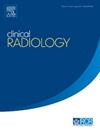非酒精性脂肪性肝病高危冠状动脉斑块与肝脏脂肪分数的相关性研究
IF 2.1
3区 医学
Q2 RADIOLOGY, NUCLEAR MEDICINE & MEDICAL IMAGING
引用次数: 0
摘要
目的应用光谱计算机断层扫描(CT)多物质分解(MMD)算法定量评估非酒精性脂肪性肝病(NAFLD)的脂肪体积分数(FVF),并探讨其与高危冠状动脉斑块(HRP)的关系。材料与方法本回顾性研究纳入了2023年8月至2024年8月诊断为冠状动脉疾病(CAD)并行冠状动脉CT血管造影和腹部增强光谱CT成像的患者。根据HRP成像特征(阳性重构、低密度斑块、点状钙化和餐巾环征)将患者分为三组:无斑块(n = 57)、非HRP (n = 54)和HRP (n = 48)组。使用频谱CT MMD算法测量FVF以量化肝脏脂肪含量。分析各组临床特征、生化指标及影像学差异。单因素和多因素logistic回归分析确定FVF和HRP之间的关系。结果HRP组fvf值(13.2%)明显高于非HRP组(9.2%)和无斑块组(6.5%)(P<0.001)。多因素二元logistic回归分析发现,FVF是HRP(比值比[OR]: 2.55, P<0.001)、高敏c反应蛋白(hs-CRP) (OR: 1.94, P=0.025)和糖尿病(OR: 9.83, P=0.002)的独立危险因素。此外,FVF与心外膜和冠状动脉周围脂肪组织(PCAT)体积和CT衰减相关(P<0.001)。结论频谱CT MMD算法可以定量评估FVF, FVF与NAFLD患者冠状动脉HRP形成独立相关。FVF升高是NAFLD患者冠心病的危险因素。本文章由计算机程序翻译,如有差异,请以英文原文为准。
Exploring the correlation between high-risk coronary plaque and hepatic fat fraction in non-alcoholic fatty liver disease using spectral computed tomography (CT)
Aim
To quantitatively assess the fat volume fraction (FVF) in nonalcoholic fatty liver disease (NAFLD) using the spectral computed tomography (CT) multimaterial decomposition (MMD) algorithm and to investigate its association with high-risk coronary plaques (HRP).
Materials and Methods
This retrospective study included patients diagnosed with coronary artery disease (CAD) from August 2023 to August 2024 who underwent coronary CT angiography and abdominal enhanced spectral CT imaging. Patients were categorised into three groups based on HRP imaging features (positive remodelling, low-density plaques, spotty calcification, and napkin ring sign): no plaque (n = 57), non-HRP (n = 54), and HRP (n = 48) groups. FVF was measured using the spectral CT MMD algorithm to quantify liver fat content. Clinical characteristics, biochemical markers, and imaging differences among the groups were analysed. Univariate and multivariate logistic regression analyses were performed to determine the association between FVF and HRP.
Results
FVF values were significantly higher in the HRP group (13.2%) compared to the non-HRP group (9.2%) and the no plaque group (6.5%) (P<0.001). Multivariate binary logistic regression analysis identified FVF as an independent risk factor for HRP (odds ratio [OR]: 2.55, P<0.001), along with high-sensitivity C-reactive protein (hs-CRP) (OR: 1.94, P=0.025) and diabetes mellitus (OR: 9.83, P=0.002). Additionally, FVF correlated epicardial and pericoronary adipose tissue (PCAT) volume and CT attenuation (P<0.001).
Conclusion
The spectral CT MMD algorithm enables quantitative assessment of FVF, which is independently associated with coronary HRP formation in NAFLD patients. Elevated FVF serves as a risk factor for CAD in patients with NAFLD.
求助全文
通过发布文献求助,成功后即可免费获取论文全文。
去求助
来源期刊

Clinical radiology
医学-核医学
CiteScore
4.70
自引率
3.80%
发文量
528
审稿时长
76 days
期刊介绍:
Clinical Radiology is published by Elsevier on behalf of The Royal College of Radiologists. Clinical Radiology is an International Journal bringing you original research, editorials and review articles on all aspects of diagnostic imaging, including:
• Computed tomography
• Magnetic resonance imaging
• Ultrasonography
• Digital radiology
• Interventional radiology
• Radiography
• Nuclear medicine
Papers on radiological protection, quality assurance, audit in radiology and matters relating to radiological training and education are also included. In addition, each issue contains correspondence, book reviews and notices of forthcoming events.
 求助内容:
求助内容: 应助结果提醒方式:
应助结果提醒方式:


